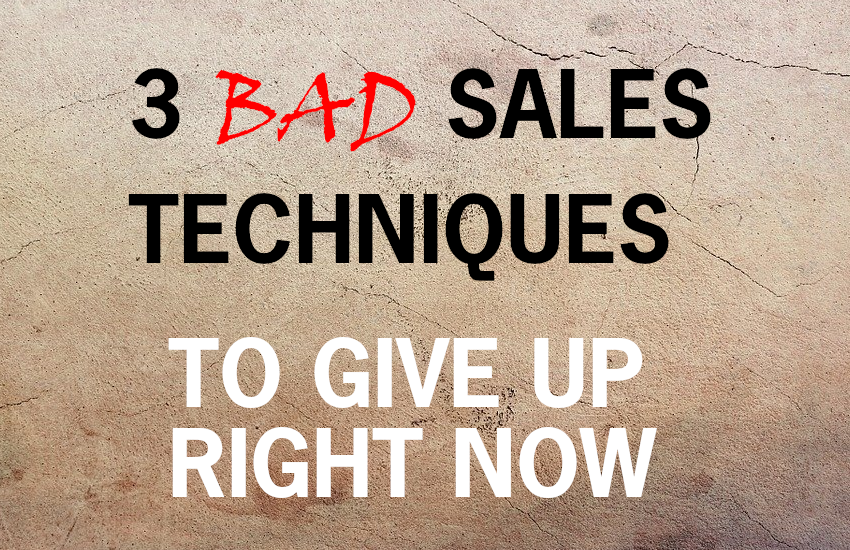3 Bad Sales Techniques You Should Give Up Right Now
You can’t swing a digital cat without hitting 50 blogs offering you the best sales tips, but it might be more important to identify the bad sales techniques that are holding us back.
Often, unlearning our bad habits is the first step toward creating new, better habits. And those better habits can lead directly to more sales, better customer relationships, and even faster lead conversions.
“Tried and true” sales techniques are exactly the ones that should be examined closely, so let’s take a look at some sales “advice” that needs to be retired immediately.
1. Fast-talking the prospect
There’s an old phrase, “Baffling with bullshit,” which basically means you keep throwing jargon and words at a rapid pace until you wear down the prospect. You might have heard this as “fast-talking,” but the basic idea is to make a sale through emotional attrition. At some point, the prospect is so overloaded with information that they give in just to shut you up.
There’s no question it’ll work, but it’ll work only once. As soon as you’re out of sight, the prospect/customer/victim will just remember how exhausting you were. They’ll also likely experience immediate buyer’s remorse and may even just cancel the service or return the product you sold to them.
Fast-talking is a good trick, certainly, but it’s no way to build a long-term customer relationship.
Listening is more important than talking. Listening is the act of gathering information about your prospect. The more information you have, the better you can make your pitch. Use this information to customize your talk-track to this customer’s specific needs.
A 20-year study found that salespeople who listened and showed care for what their customers were saying had a positive impact on sales and long-term customer relationships.
Don’t put words in your prospect’s mouth. One of the problems with talking too much is that you end up giving the prospect reasons to resist. If you say something like, “Now, I know most people are nervous about time-shares,” you are literally making them nervous about time-shares. They might not have been nervous until you said it.
People gauge their reactions against society’s expectations (it’s pretty much why civilization exists). Tell a person they might be thinking differently from everyone else and they might believe you.
If you give them objections, they’ll take them. Don’t say anything you don’t have to say, and don’t try to solve problems before they come up. This is often called “negotiating with yourself,” and you should never do it.
2. Focusing on features, not fixes
Nobody, and I mean nobody, wants to hear a salesperson start “brochuring.” The features of your service or product might be amazing and groundbreaking, but a prospect isn’t doing a book report on your product. A prospect is talking to you because they have a problem, and they need it fixed.
That’s it. And the prospect wants the problem fixed as quickly, cheaply, and safely as possible. This goes back to “listening,” mentioned above, but it’s also about cultivating an awareness of when you’re falling back on a sales script instead of addressing the prospect’s needs.
Define the benefits of your product. If your real-estate-flyer business uses high-quality paper and high-resolution printers, that’s fantastic. But that’s not why a prospect came to you. They want to know if real-estate flyers actually help with sales, if they increase attendance at open houses, if they create measurable gains that are worth the money. That’s what you need to focus on when you’re making your pitch.
Identify what the customer needs. If your email marketing service has a thousand bells and whistles, and you spend the entire call listing those bells and whistles, you’re oversaturating your prospect. They won’t remember a third of what you said, and they probably won’t care.
Listen to the prospect, and just focus on what they’ve told you. If they’re concerned about open rates, and that’s all they talk about, that’s all YOU should talk about. Let them know how your email marketing service increases open rates, and mention the options the prospect will have to boost their open rates once they become customers. That’s it!
Let them find the other features themselves, or bring them up organically over time as the relationship grows.
3. Doing everything you can do to avoid a “no”
The fear of a no can lead salespeople off-track and can actively harm the chances of converting a prospect.
A fear of a no creates too much pressure. When a salesperson pushes and pushes in an effort to avoid rejection, a prospect often realizes that they’re not being heard and that the salesperson’s drive to make a sale is more important than actually listening to the prospect’s concerns.
During a podcast interview, Don Cooper, the “Sales Heretic,” had this to say about the problem: “If we try to get the buyer to buy before they are ready, that creates conflict, and it weakens the trust that we’re trying to build with our prospect.”
The way to avoid this is to realize that sometimes prospects aren’t ready to buy. But that doesn’t mean they won’t ever buy. An unsure prospect can be contacted again a week later, and if they still trust you, they may convert then.
And finally, a “no” isn’t the end of the world. A salesperson with more failures under their belt almost always has more successes under their belt as well. Sometimes you have to play the field. When you get a no, just move on to the next prospect — lingering too long on a resistant prospect is just wasting your time.
Bad sales techniques are the ones you use on a bad prospect
The fact is, not all sales tactics work on all prospects. The best place to start is to evaluate whether your prospect is worth you time to begin with.
If you’ve never tried it, take a look at the MEDDIC method: metrics, economic buyer, decision criteria, decision process, implications of pain, and champion. In short, it’s a quick method that can help you outline whether a prospect is suited to your product — and vice versa.
Remember, our job isn’t to sell a product. It’s to become a source of ease and comfort for the customer. That should be the focus of our sales strategy. We fix their problems every time. And if we focus on that, they’ll come back.
Every time.
Latest posts by FollowUp (see all)
- CRM Integrations: Sometimes Less Is More - March 18, 2021
- Becoming an Account Executive in 5 Totally-Doable Steps - January 29, 2021
- 3 Bad Sales Techniques You Should Give Up Right Now - December 28, 2020


